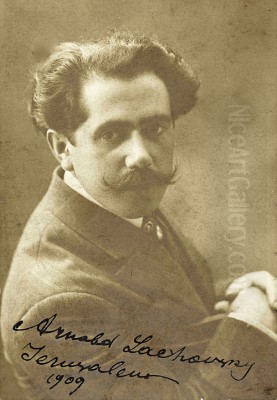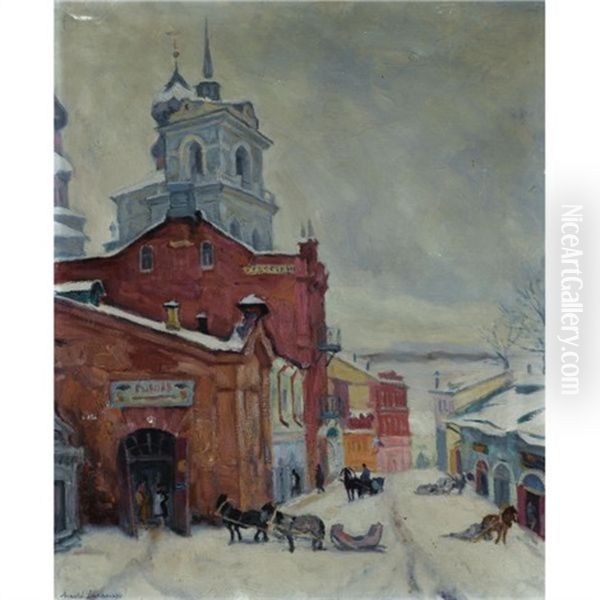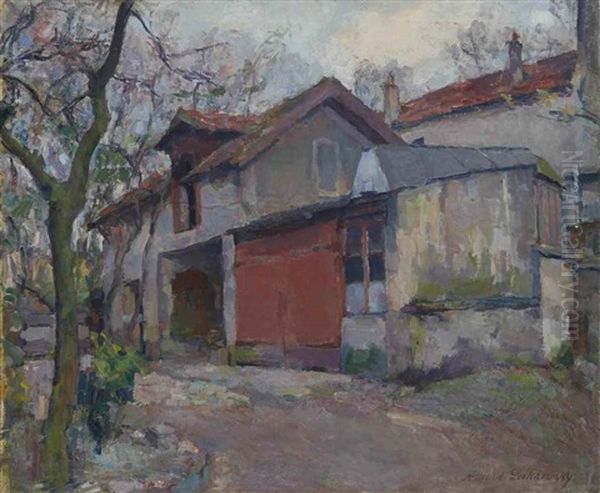
Arnold Borisovich Lakhovsky stands as a significant, though perhaps less universally heralded, figure in the landscape of early 20th-century art. A painter, graphic artist, and sculptor of Russian-Jewish heritage, his life and career traversed the tumultuous final decades of the Russian Empire, the upheaval of Revolution, the vibrant artistic centers of Europe, and finally, the promise of the New World. Born on January 27, 1880, in the town of Chernobyl, then part of the Russian Empire, and passing away on January 7, 1937, in New York City, Lakhovsky's journey reflects the complex migrations and artistic dialogues of his era. His work, primarily rooted in realism but touched by the light and atmosphere of Impressionism, captures landscapes, portraits, and scenes of daily life with sensitivity and technical skill.
Formative Years: Education Across Europe
Lakhovsky's artistic path began formally at the Odessa Art College, a notable institution in the southern region of the Empire, from which he graduated in 1902. Odessa, a cosmopolitan port city, provided a diverse cultural environment that likely shaped his early perspectives. Seeking further refinement, he traveled to Germany to study at the prestigious Munich Academy of Fine Arts. His time there, specifically in the studio of Willy von Maro, exposed him to the academic traditions and burgeoning modern trends circulating in one of Europe's key artistic hubs at the turn of the century.
His education culminated, however, in the heart of the Russian art establishment: the Imperial Academy of Arts in Saint Petersburg. There, he had the invaluable opportunity to study under two giants of Russian art: the celebrated realist master Ilya Repin and the influential drawing pedagogue Pavel Chistyakov. Repin, a leading figure of the Peredvizhniki (Wanderers) movement, instilled a deep respect for realism and socially relevant themes, while Chistyakov's rigorous system emphasized structure and form. This training provided Lakhovsky with a formidable technical foundation. His contemporaries or near-contemporaries who also benefited from the Academy's environment included figures like Valentin Serov and Igor Grabar, artists who navigated the transition from realism towards more modern sensibilities.
Early Career in Russia: Recognition and Engagement

By 1904, Lakhovsky's talent was recognized sufficiently for him to begin teaching at the Saint Petersburg Academy, a testament to his skills shortly after completing his own studies. He became an active participant in the Russian art scene, exhibiting his work regularly. His paintings, often depicting Russian landscapes and cityscapes, garnered positive attention. An early success was his painting "Rainy Day," which was acquired by the Italian government, indicating international notice even during his Russian period.
His style during these years often blended the detailed observation associated with Russian realism, reminiscent of landscape masters like Isaac Levitan (another prominent Jewish painter known for his atmospheric "mood landscapes") or Ivan Shishkin, with a growing interest in capturing fleeting effects of light and weather, hinting at Impressionist influences, perhaps absorbed from European trends or Russian interpreters like Konstantin Korovin. Works like "Russian Winter Street" exemplify his ability to convey the specific atmosphere of time and place through careful composition and nuanced color.
Beyond easel painting, Lakhovsky engaged with his cultural heritage. He contributed illustrations, including satirical cartoons, to the Yiddish magazine Der Fraynd (The Friend). Notably, his work for the magazine addressed the aftermath of the horrific Bialystok pogrom of 1906, using visual means to critique government inaction and corruption within both state and communal structures. This involvement highlights his connection to contemporary Jewish cultural and political life and his willingness to use art for social commentary.
A lesser-known but significant episode involved a brief period teaching at the Bezalel School of Arts and Crafts in Jerusalem around 1909-1910. Invited by Bezalel's founder, Boris Schatz, Lakhovsky contributed to the early development of this important institution, which aimed to forge a new Jewish national art style. This experience placed him, for a time, at the crossroads of European art training and emerging Zionist cultural aspirations.
Emigration and the Parisian Scene
The Bolshevik Revolution and the subsequent establishment of the Soviet Union created a challenging environment for many artists. While Lakhovsky continued to exhibit in the early Soviet years, holding a solo retrospective in Paris as early as 1921 (suggesting travel and connections outside Russia were possible), the changing political and artistic climate likely contributed to his decision to emigrate permanently. Around 1925, he settled in Paris, the undisputed center of the international art world.

In Paris, Lakhovsky joined a large community of émigré artists, including many from Russia and Eastern Europe. He became associated with the diverse milieu often loosely termed the École de Paris (School of Paris). While perhaps not as radically avant-garde as some figures associated with this group, such as his fellow Russian-Jewish émigrés Marc Chagall or Chaim Soutine, Lakhovsky found a place within the city's vibrant artistic life. He continued to paint landscapes, city views, and portraits, adapting his eye to French subjects while retaining his characteristic style.
His time in Paris saw continued professional activity. He participated in international exhibitions, gaining further recognition in the West. His solid academic training combined with a sensitive, often lyrical, approach to his subjects appealed to a segment of the art market that valued skillful representation alongside atmospheric effect. He navigated the Parisian scene, exhibiting alongside a wide array of artists representing various tendencies, from lingering Post-Impressionist styles to emerging modernist idioms. Figures like Moïse Kisling or Ossip Zadkine were part of this broader émigré artistic presence in Paris.
The American Chapter and Later Life
In the early 1930s, seeking new opportunities or perhaps sensing the shifting political winds in Europe, Lakhovsky moved once again, this time to the United States. He spent time in Boston, where he reportedly held a teaching position. While the exact institution, sometimes cited as the "Boston Art Academy," might be imprecise (perhaps referring to the School of the Museum of Fine Arts, Boston, or private instruction), his presence in the city's art education scene is noted. This phase reflects his lifelong commitment to both creating and teaching art.
His final years were spent primarily in New York City. He continued to work, presumably capturing American landscapes and city life, though details of his output from this period are less extensively documented than his earlier work. He remained connected to the art world, but the Great Depression undoubtedly impacted the art market and opportunities for artists across the US.
Arnold Lakhovsky died in Beth Israel Hospital in New York City on January 7, 1937. His passing marked the end of a career that spanned significant geographical and cultural shifts, always grounded in a dedication to the craft of painting.
Artistic Style and Thematic Focus
Lakhovsky's art is best characterized as a form of lyrical realism, often infused with Impressionistic sensitivity to light and atmosphere. He remained largely committed to representational art throughout his career, never fully embracing the more radical formal experiments of Cubism, Futurism, or abstraction that captivated many of his contemporaries. His strength lay in his ability to render scenes with accuracy and empathy, whether depicting the snow-covered streets of a Russian town, the gentle light of a French landscape, or the character revealed in a portrait.
His training under Repin and Chistyakov provided a strong underpinning in drawing and composition. This is evident in the solid structure of his paintings. However, his handling of paint often displayed a looser brushwork and a keen attention to color harmonies and the play of light, particularly in his landscapes. This suggests an absorption of Impressionist principles, likely encountered both in Russia (through artists like Korovin or Grabar) and more directly during his time in Munich and Paris.
His subject matter was diverse but consistently focused on the observable world. Landscapes were a major preoccupation, ranging from the specific moods of the Russian seasons to the softer climes of France. Cityscapes also feature prominently, capturing the life and architecture of places like Saint Petersburg and Paris. His portraits reveal a capacity for capturing likeness and suggesting the inner life of the sitter. Additionally, his work included still lifes and, significantly, scenes related to Jewish life, connecting back to his heritage and his earlier work for Der Fraynd. These genre scenes provide valuable visual records of cultural experience.
Compared to the stylized decorativism of the Mir Iskusstva (World of Art) artists like Alexandre Benois or Léon Bakst, Lakhovsky maintained a closer connection to observed reality. Compared to the intense expressionism of Soutine or the fantastical visions of Chagall, his work appears more restrained and traditional. Yet, within the realm of realistic and impressionistically-inflected painting, he achieved a distinct voice, marked by technical proficiency and a gentle, poetic sensibility.
Representative Works and Legacy
Several works stand out as representative of Arnold Lakhovsky's oeuvre. "Russian Winter Street," frequently depicted, showcases his skill in capturing the specific light and atmosphere of a snow-laden Russian scene, balancing architectural detail with atmospheric effect. The aforementioned "Rainy Day," recognized early in his career, likely demonstrated his ability to handle complex light and reflections.
"Open Window" (Fenêtre ouverte), known from auction records, suggests an engagement with interior/exterior themes popular among Post-Impressionists, focusing on light entering a domestic space. "Houses in Spring" points to his continued interest in landscape and the changing seasons, a theme beloved by many Russian painters, including his predecessor Levitan. His portraits, though less frequently reproduced, formed an important part of his practice.
Arnold Lakhovsky's legacy resides in his contribution to the continuation of the realist and Impressionist traditions in the early 20th century, adapted across different national contexts. As an artist who navigated the complex identities of being Russian, Jewish, and ultimately an émigré in Western Europe and America, his life reflects the broader historical currents of his time. He was a skilled painter and dedicated teacher whose work maintained a commitment to observation and craftsmanship amidst an era of radical artistic experimentation.
While perhaps overshadowed by more revolutionary figures, Lakhovsky's paintings continue to be appreciated for their technical quality, evocative atmospheres, and sensitive portrayal of people and places. His works appear regularly at auction, indicating a sustained market interest. He remains a notable figure within the history of Russian art abroad and the broader narrative of Jewish artists in the modern era, a testament to a life spent observing, rendering, and teaching the art of painting across continents and cultures. His journey from Chernobyl to New York, via Odessa, Munich, St. Petersburg, Jerusalem, and Paris, encapsulates a remarkable artistic pilgrimage through a transformative period in world history.